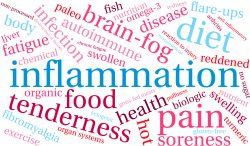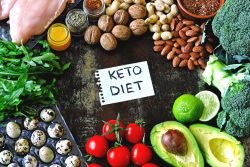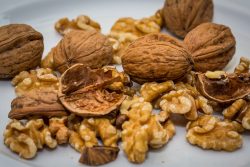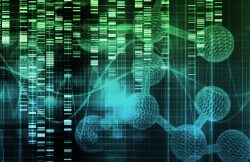How Does Soybean Oil Affect Your Health?
 New research at UC Riverside has shown that soybean oil which is America’s most widely consumed oil not only leads to diabetes and obesity, but could also have neurological affects on the brain. These affects could lead to Alzheimer’s Disease, anxiety, depression and even autism.
New research at UC Riverside has shown that soybean oil which is America’s most widely consumed oil not only leads to diabetes and obesity, but could also have neurological affects on the brain. These affects could lead to Alzheimer’s Disease, anxiety, depression and even autism.
Soybean oil is used in fast food frying, is added to packaged foods and is fed to livestock. And it appears in all likelihood it is not healthy for humans to consume. It is not good for mice. The recent study compared mice fed three different diets high in fats – soybean oil, soybean oil modified to be low in linoleic acid and coconut oil.
The same research team in 2015 discovered that soybean oil induces diabetes, insulin resistance, obesity and fatty liver in mice. In a 2017 study, this same team learned that if soybean oil is engineered to be low in linoleic acid, it induces insulin resistance and obesity.
In the new study released this month, the team did not find any difference between the unmodified soybean oil and the modified soybean oil’s effects on the brain. The team found pronounced effects of the oil on the hypothalmus which is a part of the brain where a number of critical processes happen.
The hypothalmus regulates body weight through metabolism, maintains body temperature and is critical for physical growth and reproduction as well as response to stress.
The research team discovery determined a number of genes in mice who were fed soybean oil were not functioning properly. One such gene produces oxytocin, the love hormone. In mice fed soybean oil the levels of oxytocin in the hypothalmus went down.
The team discovered about 100 other genes that were also affected by the soybean oil diet. They believe the discovery could have ramifications not only for energy metabolism, but also for proper brain function and a variety of diseases such as Parkinson’s and autism. However, they did note that there is not actual proof that soybean oil causes these diseases.
The team also notes that their findings only apply to soybean oil, not other soy products or to other types of vegetable oils. Many soy products contain small amounts of the oil and large amounts of healthful compounds such as proteins and essential fatty acids.
It is also important to note that the study was conducted on mice and mouse studies don’t always translate the same to humans. And the study utilized male mice. Because oxytocin is very important for maternal health and promotes mother/child bonding, similar studies will need to be performed using female mice.
The team has not isolated exactly which chemicals in soybean oil are responsible for changes they found in the hypothalmus. They have however ruled out two candidates. It is not the linoleic acid since the modified soybean oil also produced genetic disruptions. Nor is it stigmasteral which is a cholesterol like chemical found naturally in the oil.
The team’s future research will include identifying the compounds responsible for the negative effects. Their research could help design healthier dietary oils in the future. The dogma is that any saturated fat is bad and unsaturated fats are good. Soybean oil is actually a polyunsaturated fat but the thought that it is good for you is not proven.
Coconut oil which contains saturated fats, produced very few changes in the hypothalmic genes. The take away now is reduce the consumption of soybean oil.
To view the original scientific study click below
Omega-6 and omega-3 oxylipins are implicated in soybean oil-induced obesity in mice



 Chronic inflammation is tough on the body and now through a recent study we have one more thing to be worried about. This study published in Neurology indicates that chronic inflammation in middle age may lead to problems with memory and thinking in the years leading up to old age.
Chronic inflammation is tough on the body and now through a recent study we have one more thing to be worried about. This study published in Neurology indicates that chronic inflammation in middle age may lead to problems with memory and thinking in the years leading up to old age. A new study has estimated that improving rates of hand washing by travelers going through only ten of the world’s leading airports may greatly reduce spreading a good number of infectious diseases. Additionally, the greater the improvement in how people wash their hands in airports, the even more dramatic effect on slowing down the spread of disease.
A new study has estimated that improving rates of hand washing by travelers going through only ten of the world’s leading airports may greatly reduce spreading a good number of infectious diseases. Additionally, the greater the improvement in how people wash their hands in airports, the even more dramatic effect on slowing down the spread of disease.  An international research team which was led by physician/scientists at the University of California San Diego School of Medicine has described a new process for delivering neural precursor cells (NSCs) to rats with spinal cord injuries. The process reduced the risk of additional injury and boosted the propagation of potentially repairing cells.
An international research team which was led by physician/scientists at the University of California San Diego School of Medicine has described a new process for delivering neural precursor cells (NSCs) to rats with spinal cord injuries. The process reduced the risk of additional injury and boosted the propagation of potentially repairing cells. Researchers have now found that specifically programmed materials under very specific conditions can encourage stem cells to transform into bone cells. To achieve this, scientists implemented a so called shape memory polymer in stem cell research.
Researchers have now found that specifically programmed materials under very specific conditions can encourage stem cells to transform into bone cells. To achieve this, scientists implemented a so called shape memory polymer in stem cell research. Yale researchers studying mice have found that a ketogenic diet can produce health benefits in the short term, however produce negative effects after approximately a week. Their results do offer early indications that this diet could over limited time periods improve human health by lowering inflammation and the risk of diabetes.
Yale researchers studying mice have found that a ketogenic diet can produce health benefits in the short term, however produce negative effects after approximately a week. Their results do offer early indications that this diet could over limited time periods improve human health by lowering inflammation and the risk of diabetes. Researchers at Penn State have found that consuming walnuts on a daily basis as part of a healthy diet was linked to increases in certain bacteria that can help promote health. Those changes in the gut bacteria were also linked with improvements in some risk factors for diseases of the heart.
Researchers at Penn State have found that consuming walnuts on a daily basis as part of a healthy diet was linked to increases in certain bacteria that can help promote health. Those changes in the gut bacteria were also linked with improvements in some risk factors for diseases of the heart. Recent research has discovered evidence that supports previous anecdotes that stress can cause hair to go gray. The findings advance the knowledge that stress impacts the human body.
Recent research has discovered evidence that supports previous anecdotes that stress can cause hair to go gray. The findings advance the knowledge that stress impacts the human body.  With opioid addiction in crises resulting in destroying peoples lives and also resulting in countless deaths, finding non-addictive treatments for pain is the goal of scientists around the world. Pain is real and in Australia alone where the new research has been conducted, it was estimated that the total cost of chronic pain was over $139 billion.
With opioid addiction in crises resulting in destroying peoples lives and also resulting in countless deaths, finding non-addictive treatments for pain is the goal of scientists around the world. Pain is real and in Australia alone where the new research has been conducted, it was estimated that the total cost of chronic pain was over $139 billion. Researchers have developed a new technique for gene therapy by transforming human cells into mass producers of nano sized particles which are full of genetic material. This genetic material has the potential to reverse a variety of disease processes.
Researchers have developed a new technique for gene therapy by transforming human cells into mass producers of nano sized particles which are full of genetic material. This genetic material has the potential to reverse a variety of disease processes.